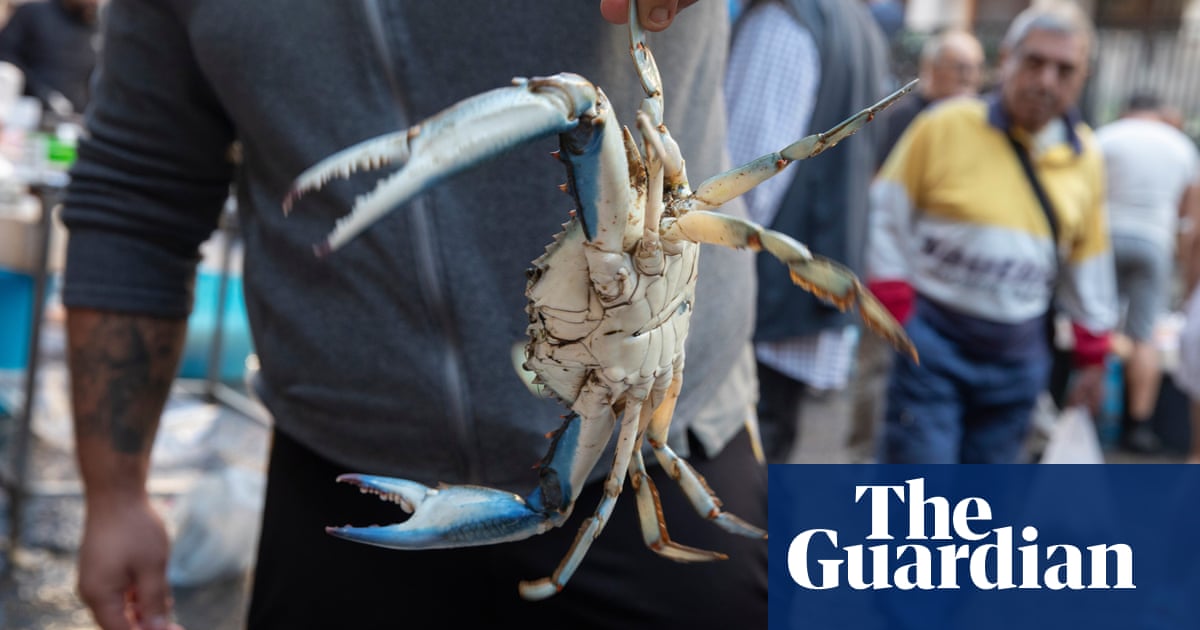‘Anything can be edible’: how Italians are making a meal of invasive crabs | Seafood


In a down-to-earth suburb of Catania on Sicily’s east coast, smoke billows from street stands selling traditional grilled horse meat, and local youngsters gather around kiosks selling the region’s unique handmade drink, seltz limone e sale (seltzer with lemon and sea salt). It is here that a family of charismatic ex-fishers have opened a seafood restaurant that bravely challenges long-held regional conventions.
The Salamone family sell all the usual local specialities in their slick new business “La Fish”, such as Sicily’s famous swordfish, sardines and tuna. However, the feature of tonight’s tasting menu – attracting customers who range from local families to food connoisseurs – is a relative newcomer to these shores and to Sicilian tables: the Atlantic blue crab.
Inside the restaurant, about half a dozen blue crabs are displayed on a large fish counter alongside an array of other seafood. These crabs, with their striking blue claws and olive-green shells, are creating a crisis for Italy. Originating from the western Atlantic Ocean, they have no natural predators in the Mediterranean and feed on young clams, disrupting traditional shellfish harvests and affecting Italy’s position as one of the top clam producers in the world.
So some Italians, like the Salamones, have adapted by incorporating these crustaceans into their cuisine.
“I love the blue crab,” says chef Mario Contadino, who is in charge of tonight’s dinner at La Fish, citing its delicious and sweet taste that, he says, adds depth to any dish. To entice local people to try this alien critter, he serves it on sticky sushi rice with onions, bell peppers, garlic, tomatoes and coriander, adorned with vibrant, edible yellow flowers.
He says people in Catania can be “closed-minded” when it comes to trying unfamiliar ingredients such as the blue crab. “It’s possible people may think to themselves, ‘What is this?’ or say, ‘Oh no, I don’t like this.’” But he believes the taste will speak for itself and win over even the most sceptical diners. “That first bite does not lie.”
Francesco Tiralongo, a marine biologist at the University of Catania, has documented the explosive population growth of the blue crab. He explains how rising water temperatures in the Mediterranean, have made Sicilian waters a welcoming environment for such alien species. “Changing fish consumption habits in Sicily to include alien species like the blue crab is a necessary response to climate change and current ecological challenges,” he says.
The blue crab can also now frequently be found in Catania’s famous fish market behind the city’s Piazza del Duomo. On a warm day, the market bustles with activity – a cacophony of sounds, sights, and smells. Fishers, traders, local people and tourists mingle in narrow alleys, stepping over black cobblestones covered in bright crimson blood, as fishmongers cut large chunks of silvery swordfish and tuna.
On a small wooden table, holding a large knife next to buckets filled with crustaceans and fish, is Rosario, a local fishmonger who has been selling blue crab for the past few months. “I sell it because people like it,” he says. Having started with just a few kilos of blue crab a day, he now averages sales of about 20 kilos daily.
Rosario says the traditional crustaceans he used to sell are not so readily available, but he gets “more and more of these blue crabs” from the fishers he buys from.
Though it may be an unfamiliar ingredient in Sicily, he says it helps that blue crabs are no different from the many varieties of crustaceans the Catanese eat as a staple part of their diet. “Here in Sicily, we eat fish every day.”
“People are getting to know it,” Rosario says, adding that they seem to really like its delicate and tender taste. Most of his customers prefer to eat blue crabs with spaghetti in tomato sauce, while he prefers to eat his crab boiled. “A very good dish,” he says.
For now, Rosario only sells the Atlantic blue crab. He says other invasive species such as scorpion fish, lionfish and the silver-cheeked toadfish are too strange for his customers, adding: “They would not eat them.”
The island needs a new way to deal with the interlopers, as the rising numbers of blue crabs are now causing serious economic pain to local Sicilian fishers, who are already facing a crisis over dwindling fish populations. Alberto Pulizzi, the director general of the fisheries department of the Sicilian regional government, says the crabs are destroying fishers’ nets and eating clams and mussels. These molluscs are highly prized in Italian dishes such as spaghetti alle vongole (pasta with clams).
Tommaso Salamone says the family’s major motivation for starting their restaurant a few months ago was to take a new approach to the invaders, presenting them as something desirable. In other words – if you can’t beat ’em, eat ’em. He says: “We are making these dishes with blue crab to show people that anything can be edible.”
This report was supported by Journalismfund Europe
Source link




